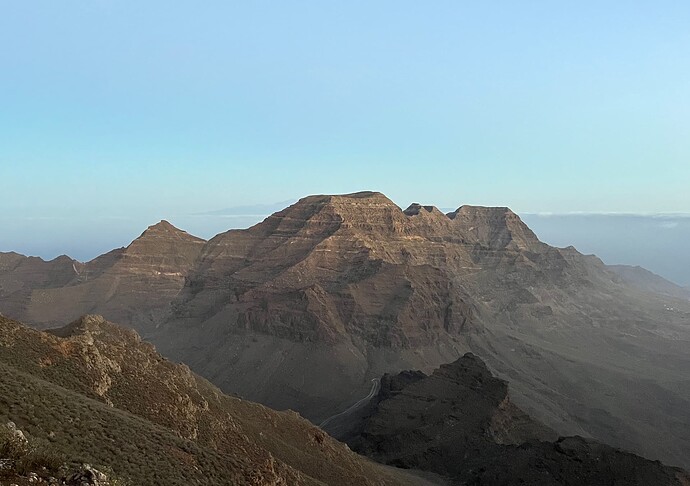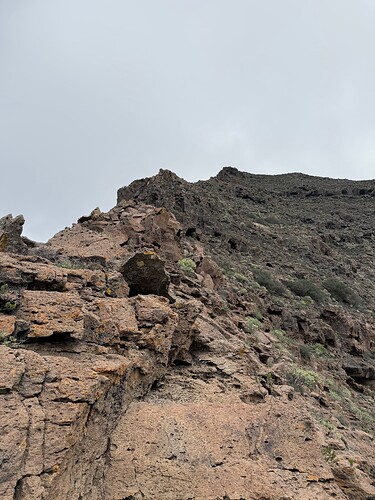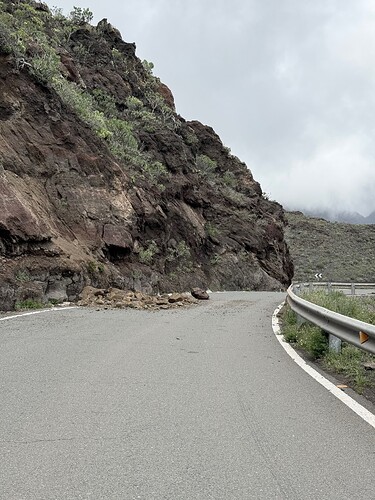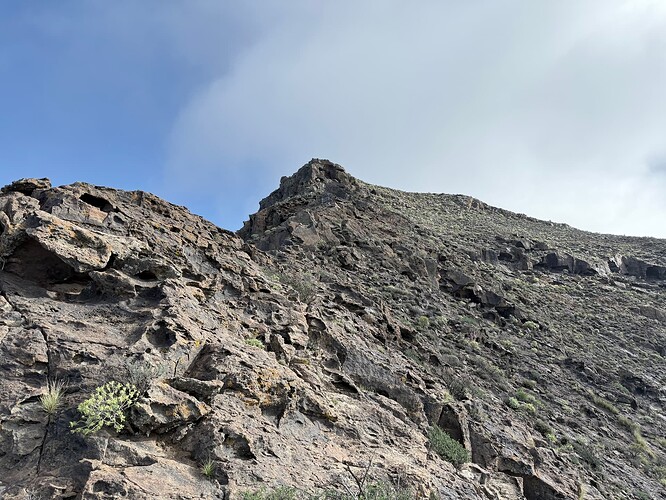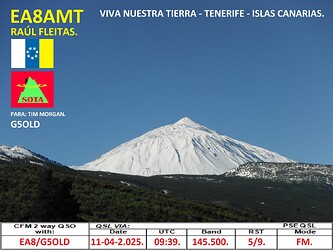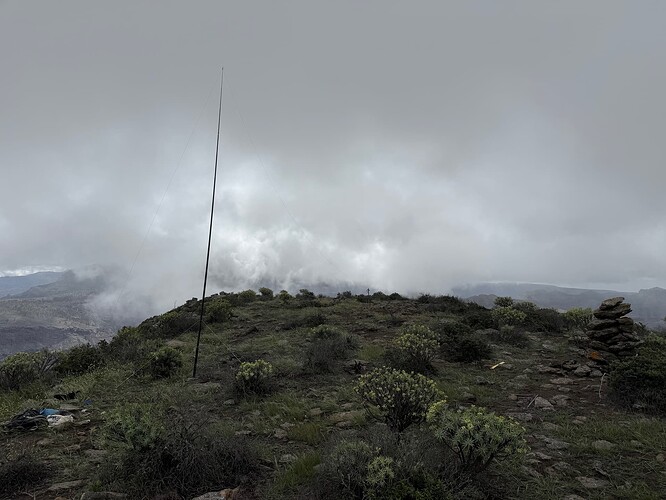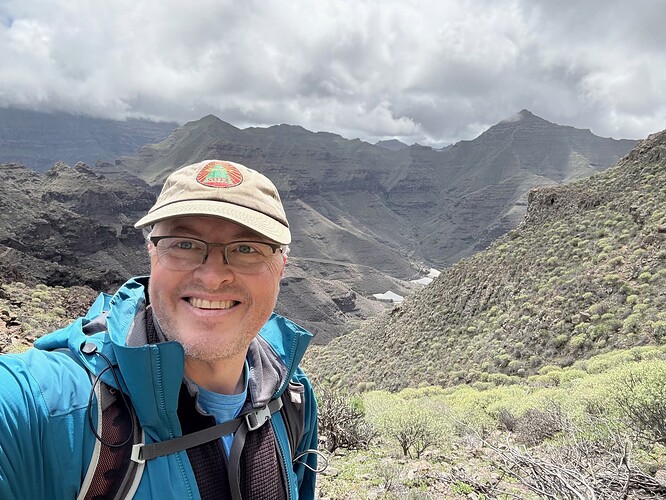Montaña de Hogarzales (EA8/GC-013) – A SOTA Adventure into the Basalt Ridden Wild West of Gran Canaria
Montaña de Hogarzales (EA8/GC-013) from Montaña del LechugalEA8/GC-015 in 2024
The west coast of Gran Canaria had left a deep impression on me during my visit last year; Its rugged basalt terrain had destroyed my boots so thoroughly that they needed to be restitched and repaired when I got home. So this year, I came better prepared, bringing along an older pair of boots I wouldn’t mind sacrificing to the volcanic gods of the island.
Basalt ridgeline on Hogarzales
The Untamed West
The western flank of Gran Canaria is a world apart from the Pac-Man SOTA peaks in the forested center. This is raw terrain - formed during one of the earlier ancient volcanic phases when GC was a shield volcano, forming a region of towering basalt cliffs and steep ravines that rise directly from the ocean. Unlike the central caldera formed with later explosive eruptions, these summits don’t carry the same altitude, but they make up for it in drama. The landscape demands respect, with plenty of hands-on scrambling, route-finding challenges, Basalt that bites hard, leaving no room for complacency.
Basalt ridges rising from the sea
A Delayed Start
My morning departure was delayed due to a rare weather event the night before. Heavy rain had lashed the west coast - a phenomenon I understand only happens only a few times a decade. The aftermath was obvious: the mountain sides in bloom and “slightly green” and rockfalls littering the roads. I had to stop at one point to clear debris just to pass so early in them morning. Even more surreal were the waterfalls - cascading torrents pouring down otherwise dry desert cliffs, a remarkable sight in this arid part of the island.
Blocked roads
The Approach
Using OSM, I’d identified what looked like a viable trail to the summit. But getting to the ridgeline was an adventure in itself. I had to pick my way through thorny shrubs and clusters of cacti—each step demanding a prickly caution. I really didn’t want to spend the rest of the hike pulling spines out of my legs ![]() .
.
Once I hit the ridge, things became more straightforward. I made steady progress until I hit the first serious obstacle: a line of cliffs that required a route-finding traverse around to a gully, which brought me up to a col at approximately 820 meters. With line of sight to Tenerife, I messaged EA8AMT - who’d generously offered advice ahead of the activation - to let him know I was running late thanks to the previous night’s rockfall chaos. Big thanks to google translate here ![]()
Summit with col round the corner to the left. One of the many cliff lines visible
Scrambling to the Summit
After the col, the real climbing began. The route steepened dramatically, and I found myself having to engage scrambling mode. Route-finding was tricky as I tried to avoid the worst of the rocky outcrops.
Summit ridgeline scrambling
Around 45 minutes later, I finally emerged onto the summit plateau. A quick snack restored my spirits just as I heard EA8AMT and EA8CCA calling from Tenerife on 2 meters, anticipating my arrival.
Summit in sight
SOTA Time
I set up for 2m first, quickly making several QSOs with Tenerife stations thanks to the excellent line of sight. Bit thanks to the welcome and support from EA8AMT and EA8CCA, even if i understand very little. Muchas gracias, Raúl
QSO card from EA8AMT
It was then time to switch to HF. I deployed my 10.9m inverted-L vertical and began calling on 10m. Signals reached mainland Europe but not northern Europe or the UK, so I shifted to 15m, hoping for better propagation—and it paid off. MM0EFI called in with a 55 signal from his new delta loop and spotted me, triggering a mini pile-up with several summit-to-summit contacts. Clearly, 15m was the band of the day for European DX.
Lastly, I tried 40m. It’s rare to hear anything on this band during the day from Gran Canaria summits—there’s virtually no local noise, and the band felt eerily quiet. So different from mainland Europe. I did, however, manage to work Alfredo, EC8ADS - a dedicated 10m chaser I’ve worked many times from UK summits.
The Descent and Aftermath
The descent proved punishing. Thats is when my boots get hammered. At one point, a chunk of the trail crumbled beneath me, and I caught a sharp graze on my calf. Nothing serious, although my wife thinks differently! A definite a reminder that this is not forgiving terrain.
My boots? Wrecked again. But this was just the beginning of this trip - more basalt massifs await on the west coast:
- Mogarenes (EA8/GC-017)
- Montaña de Aguas Sabinas (EA8/GC-019)
This isn’t just SOTA. This is SOTA on volcanic steroids.
